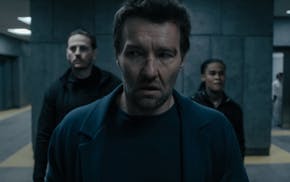What the Dead Leave Behind
By David Housewright. (Minotaur, 310 pages, $25.99.)
Granted, books that are set in our own backyards often are more fun to read. We know the office park, the lake, the riverfront condos. But even if David Housewright's retired detective Rushmore McKenzie was ambling his way through Philadelphia, this would be a hoot of a novel.
McKenzie, now a private investigator on his own terms, takes on a murder case where the trail long ago ran cold. The factions grow to involve a local cosmetics empire with a sex addict CEO, his girlfriend's daughter and her volatile male friend and, irresistibly, a group called the New Brighton Hotdish, a clutch of parents who bonded on the sidelines of the kids' baseball games and have remained a tightly bound, or wound, clique.
Housewright, a past Edgar Award winner, has written more than a dozen McKenzie mysteries, and his ease with this character is charming, especially the way he lets us inside McKenzie's sardonic "inner voice." There are double-crosses, Lake Minnetonka soirees, laughs, dangers and enough misdirects to keep you in the weeds.
Housewright, who lives in St. Paul, makes a convincing case for there being no such thing as coincidence.
KIM ODE
The Portrait By Antoine Laurain, translated from the French by Jane Aitken and Emily Boyce. (Gallic Books, 112 pages, $13.95.)
Quick, before summer ends, find a copy of this light novel by Antoine Laurain and curl up with it on your porch swing. It'll take just an afternoon to read, this modern-day story with an old-fashioned feel. The narrator of "The Portrait" — Pierre-Francois Chaumont, a snooty, romantic, erudite, slightly unpleasant creature — is an antiques collector. (His wife does not approve and is constantly trying to pare down their stuff.) One day at an auction, Pierre sees a portrait of a mysterious 18th-century gentleman — a man who looks exactly like him. And so he buys it, for a ridiculous sum of money.
Pierre's cranky wife doesn't see the resemblance, and she takes to mocking him for his pretentiousness. (He, on the other hand, has lied to her about how much money he spent on the painting. Clearly, not a happy marriage.) One thing leads to another, a fight ensues, Pierre passes out (or falls asleep) and when he awakens (or does he? is this all a dream?) he wraps up the portrait, puts it into the car and drives off — straight into the life of the man in the painting.
Laurain's charming story can be read straight, as a fantastic coincidence and a satisfying love story. Or it can be read as a fable — about starting over, about finding true love (which, indeed, he does, whether he deserves it or not), about identity, about how we are defined by our possessions. However you choose to read it, it's delightful.
LAURIE HERTZEL

Birdhouses don't attract most birds
How to turn a supermarket bouquet into a lusher, more personalized flower arrangement
Award-winning director Mohammad Rasoulof sentenced to prison in Iran ahead of Cannes
Spanish court shelves latest tax probe of Shakira following prosecutors' recommendation

